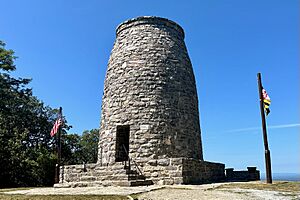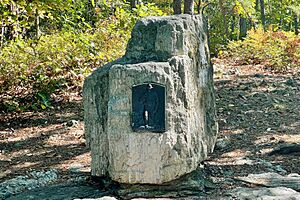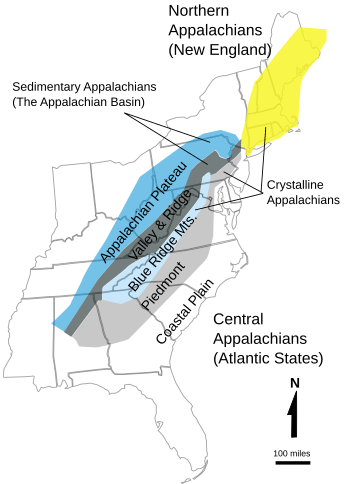South Mountain (Maryland and Pennsylvania) facts for kids
Quick facts for kids South Mountain |
|
|---|---|

Northward view of South Mountain near Interstate 70 in Maryland
|
|
| Highest point | |
| Peak | Quirauk Mountain |
| Elevation | 2,150 ft (660 m) |
| Dimensions | |
| Length | 70 mi (110 km) |
| Width | 12 mi (19 km) |
| Geography | |
| Country | United States |
| Range coordinates | 39°43.2′N 77°29.5′W / 39.7200°N 77.4917°W |
| Parent range | Blue Ridge Mountains |
| Geology | |
| Orogeny | Grenville orogeny |
| Type of rock | Granite, gneiss and limestone |
South Mountain is a long mountain range that stretches into Maryland and Pennsylvania. It's actually the northern part of the Blue Ridge Mountains. This mountain range runs for about 70 miles (113 km) from the Potomac River in Maryland all the way to Dillsburg, Pennsylvania. It acts like a natural wall, separating the Hagerstown and Cumberland valleys from the lower, rolling lands called the Piedmont regions.
The famous Appalachian Trail, a long hiking path, follows the very top of South Mountain through Maryland and part of Pennsylvania.
Contents
Exploring South Mountain's Geography
South Mountain starts small and narrow near the Potomac River. Here, it's only about one mile wide and its highest point is around 1,200 feet (366 meters) above sea level. South of the Potomac, in Virginia, the ridge continues as Short Hill Mountain.
As you travel north through Maryland, South Mountain gradually gets taller and wider. Near the Pennsylvania border, it joins with the nearby Catoctin Mountain range. This makes it feel more like a group of mountains than just one ridge. North of U.S. Route 30 in Pennsylvania, the mountain range becomes its widest, stretching over 12 miles (19 km). Some peaks here even reach over 2,000 feet (610 meters) high! The mountain then turns more to the east, ending as a series of smaller, rocky hills near Dillsburg, Pennsylvania.
Tallest Spots in Maryland

Here are some of the main peaks (tallest points) on South Mountain in Maryland, listed from south to north:
- Lambs Knoll: 1,758 feet (536 meters)
- Monument Knob: 1,540 feet (469 meters)
- Bartman Hill: 1,400 feet (427 meters)
- Pine Knob: 1,714 feet (522 meters)
- Buzzard Knob: 1,520 feet (463 meters)
- Quirauk Mountain: 2,150 feet (655 meters) – This is the highest point on South Mountain in Maryland!
Tallest Spots in Pennsylvania

Here are some of the main peaks on South Mountain in Pennsylvania, listed from south to north, then east:
- Mount Dunlop: 1,720 feet (524 meters)
- Monterey Peak: 1,663 feet (507 meters)
- Clermont Crag: 1,627 feet (496 meters)
- Wildcat Rocks: 1,772 feet (540 meters)
- Virginia Rock: 1,818 feet (554 meters)
- Buzzard Peak/Chimney Rocks: 1,946 feet (593 meters)
- Snowy Mountain: 2,090 feet (637 meters)
- Green Ridge: 1,980 feet (604 meters)
- Mount Newman: 1,784 feet (544 meters)
- Piney Mountain: 1,904 feet (580 meters)
- Big Pine Flat Ridge: 2,100 feet (640 meters) – This is the highest point on South Mountain in Pennsylvania!
- Big Flat Ridge: 2,065 feet (630 meters)
- East Big Flat Ridge: 2,070 feet (631 meters)
- Mount Holly: 1,504 feet (458 meters)
- Long Mountain: 1,583 feet (482 meters)
- Center Point Knob: 1,075 feet (328 meters) – This was once the middle point of the Appalachian Trail in 1935.
- White Rocks: 1,105 feet (337 meters)
Mountain Passes and Gaps
Gaps are low points or passes in the mountain range, often used for roads or trails.
Gaps in Maryland
From south to north:
- Crampton's Gap: 930 feet (283 meters)
- Fox's Gap: 1,070 feet (326 meters)
- Harman Gap (also called Oeiler's Gap): 1,570 feet (479 meters)
- Turner's Gap: 1,071 feet (326 meters) – U.S. Route 40 Alternate crosses here.
Gaps in Pennsylvania
From south to north:
- Monterey Gap: 1,330 feet (405 meters) – Located at Blue Ridge Summit.
- Pass near Mount Newman: 1,380 feet (421 meters) – U.S. Route 30 crosses this pass.
Protected Areas and Parks
Many parts of South Mountain are protected as state parks and forests, offering places for hiking, camping, and enjoying nature.
Parks in Maryland
From south to north:
- South Mountain State Park: This park covers the entire ridge crest in Maryland.
- Gathland State Park: Located at Crampton Gap.
- Washington Monument State Park: Near Boonsboro.
- Greenbrier State Park: Also near Boonsboro.
Parks in Pennsylvania
From south to north:
- Michaux State Forest: This forest covers most of the mountain in Pennsylvania.
- Caledonia State Park: East of Fayetteville.
- Kings Gap State Park
- Pine Grove Furnace State Park: This park is currently the midpoint of the Appalachian Trail.
Protecting South Mountain's Beauty
In Pennsylvania, there's a special effort called the Conservation Landscape Initiative focused on protecting the South Mountain region. This project is led by the Pennsylvania Department of Conservation and Natural Resources (DCNR) and the Appalachian Trail Conservancy. Many different groups, businesses, and community members work together in this effort, which is called the South Mountain Partnership. They all want to keep this beautiful area healthy and natural for the future.
A Look Back: South Mountain's History
South Mountain played a big role in the early history of western Maryland. It was seen as a natural border by the Susquehannock (Conestoga) people. In 1732, a chief named Togotolisa warned the governor of Maryland not to let settlers move into the valley beyond the mountain.
The first land given to European settlers west of South Mountain by Maryland was in 1731. Early roads, like the Great Wagon Road, crossed South Mountain through gaps like Fox's Gap and Turner's Gap. These passes were important for people moving west to settle new lands. Maryland finally gained full control of the lands west of South Mountain in 1744.
After John Brown's raid on Harpers Ferry in 1859, some of his raiders escaped by following South Mountain north into Pennsylvania. They traveled at night and hid during the day in the thick forests along the ridge. They eventually left the mountain near what is now Caledonia State Park.
South Mountain was also a battlefield during the American Civil War. The Battle of South Mountain was fought here in 1862 at Crampton's, Fox's, and Turner's gaps. In 1863, during Robert E.Lee's invasion of Pennsylvania, there were more fights on the mountain, including the Fight at Monterey Pass.


